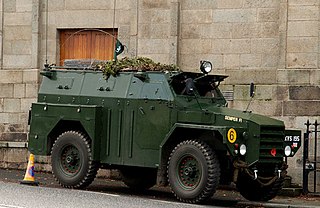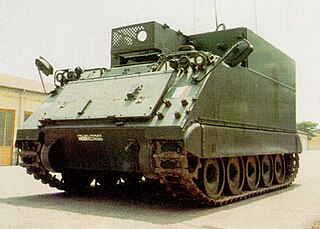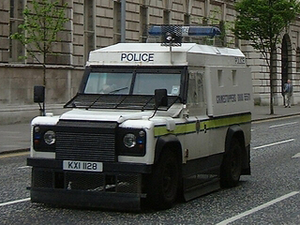
Armour or armor is a covering used to protect an object, individual, or vehicle from physical injury or damage, especially direct contact weapons or projectiles during combat, or from a potentially dangerous environment or activity. Personal armour is used to protect soldiers and war animals. Vehicle armour is used on warships, armoured fighting vehicles, and some combat aircraft, mostly ground attack aircraft.

The Land Rover Discovery is a series of seven-seater family SUVs, produced under the Land Rover marque, from the British manufacturer Land Rover, and later Jaguar Land Rover. The series is currently in its fifth iteration, the first of which was introduced in 1989, making the Discovery the first new model series since the launch of the 1970 Range Rover – on which it was based – and only the third new product line since the conception of the Land Rover by Rover in 1948. The model is sometimes called influential, as one of the first to market a true off-road capable family car.

The Land Rover Defender is a series of British off-road cars and pickup trucks. They consistently have four-wheel drive, and were developed in the 1980s from the original Land Rover series which was launched at the Amsterdam Motor Show in April 1948. Following the 1989 introduction of the Land Rover Discovery, the term 'Land Rover' became the name of a broader marque, and thus no longer worked as the name of a specific model; thus in 1990 Land Rover renamed the 90 and 110 as Defender 90 and Defender 110 respectively. The 127 became the Defender 130.

The BRDM-2 is an amphibious armoured scout car designed and developed in the Soviet Union. It was also known under the designations BTR-40PB, BTR-40P-2 and GAZ 41-08. This vehicle, like many other Soviet designs, has been exported extensively and is in use in at least 38 countries. It was intended to replace the older BRDM-1, and has improved amphibious capabilities and better armament compared to its predecessor.

Military vehicles are commonly armoured to withstand the impact of shrapnel, bullets, shells, rockets, and missiles, protecting the personnel inside from enemy fire. Such vehicles include armoured fighting vehicles like tanks, aircraft, and ships.

The FV432 is the armoured personnel carrier variant in the British Army's FV430 series of armoured fighting vehicles. Since its introduction in the 1960s, it has been the most common variant, being used for transporting infantry on the battlefield. At its peak in the 1980s, almost 2,500 vehicles were in use.

The Humber Pig is a lightly armoured truck used by the British Army from the 1950s until the early 1990s. The Pig saw service with the Royal Ulster Constabulary (RUC) chiefly as an armoured personnel carrier from late 1958 until early 1970. The Pig became particularly well known from its presence on the streets of Northern Ireland during the worst of the Troubles.

The FV603 Saracen is a six-wheeled armoured personnel carrier designed and produced by Alvis from 1952 to 1976. It has been used by a variety of operators around the world and is still in use in secondary roles in some countries. The Saracen became a recognisable vehicle as a result of its part in Operation Banner in Northern Ireland as well as for its role in the South African government's enforcement of apartheid.

The Shorland is an armoured patrol car that was designed specifically for the Royal Ulster Constabulary by Frederick Butler. The first design meeting took place in November 1961. The third and final prototype was completed in 1964 and the first RUC Shorlands were delivered in 1966. They were reallocated to the Ulster Defence Regiment in 1970. The Royal Ulster Constabulary soon replaced the Shorland with an armoured Land Rover with more conventional profile and no machine gun turret.

The TPz Fuchs from Transportpanzer Fuchs is a German armoured personnel carrier originally developed by Daimler-Benz, and manufactured and further developed by the now Rheinmetall MAN Military Vehicles (RMMV). Fuchs was the second wheeled armoured vehicle to enter service with the Bundeswehr. It can be used for tasks including troop transport, engineer transport, bomb disposal, Nuclear, Biological and Chemical reconnaissance and electronic warfare. RMMV and its predecessors manufactured 1,236 Fuchs 1, mostly for the German Army.

BTR-90 (GAZ-5923) is an 8×8 wheeled armored personnel carrier developed in Russia, designed in 1993 and first shown publicly in 1994. It is a larger version of the BTR-80 vehicle, fitted with a BMP-2 turret.

The SK-105 Kürassier is an Austrian light tank armed with a rifled 105 mm gun in an oscillating turret. It is estimated that over 700 have been produced, with initial deliveries in 1971. It shares its CN 105-57 main gun with the French AMX-13, which was widely produced and deployed.

The Land Rover Wolf is a light military vehicle based on the Land Rover Defender introduced in 1994. The MoD designates the Wolf 90 as Truck Utility Light (TUL) HS and the Wolf 110 as Truck Utility Medium (TUM) HS, where HS stands for High Specification. Land Rover calls it eXtra Duty (XD).

The Snatch Land Rover is a protected patrol vehicle based on the Land Rover Defender 110 chassis. Intended for general patrolling in low-threat areas, the vehicle was developed in 1992 for use in Northern Ireland. It provides a limited degree of small arms protection for occupants and a limited level of protection from Improvised Explosive Devices and off-route mines.
The Mohafiz is a family of internal security vehicles designed and manufactured by Heavy Industries Taxila with Cavalier Group also designing later production models.

Improvised vehicle armour is a form of vehicle armour consisting of protective materials added to a vehicle such as a car, truck, or tank in an irregular and extemporized fashion using available materials. Typically, improvised armour is added in the field and it was not originally part of the design, an official up-armour kit, nor centrally planned and distributed. Improvised armour is used to protect occupants from small arms, crew-served weapons, artillery fire, and mines. Improvised additions have included metal plate, scrap metal, sandbags, concrete, wood, and, since at least the 2000s, Kevlar. These materials vary widely in their ballistic protection.

Non-military armoured vehicles are armoured vehicles used outside professional armed forces. While primarily invented and used for defense/internal conflicts from an equally well armed organized force, armour technology has found a number of other uses outside of this military context.
The Gazelle FRV or Fast Reconnaissance Vehicle is a 4×4 infantry fighting vehicle (IFV) built for reconnaissance on the chassis of the Mercedes-Benz Unimog light truck developed by Zimbabwe in the early 1980s.

Terrängbil m/42 KP, meaning "terrain car m/42 KP", colloquially known as "KP-car", was an early Swedish infantry fighting vehicle developed during World War II. It is at its core a flatbed truck with 4 wheel drive for off-road driving, fitted with an armoured body elongated over and around the bed with a troop transport compartment behind the cabin for a panzergrenadier squad of 16.

The M577 Command Post Carrier, also known as the M577 Command Post Vehicle or Armored Command Post Vehicle, is a variant of the M113 armored personnel carrier that was developed and produced by the Food Machinery and Chemical Corporation (FMC) to function on the battlefield as a mobile command post i.e. a tactical operations centre, usually at the battalion level. In U.S. military service its official designation is Carrier, Command Post, Light Tracked M577.





















